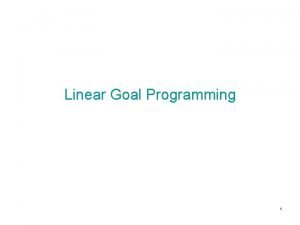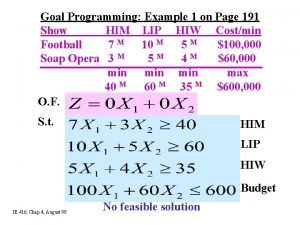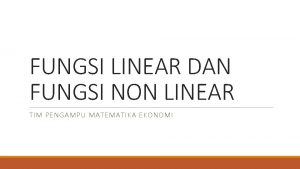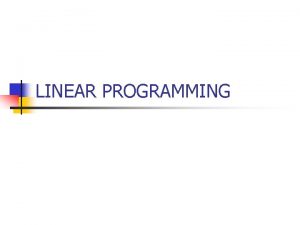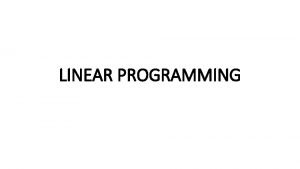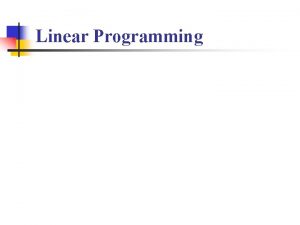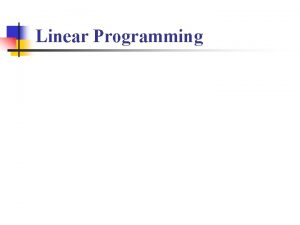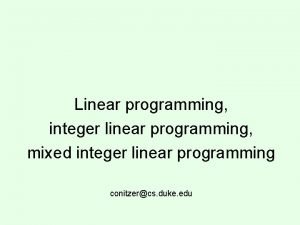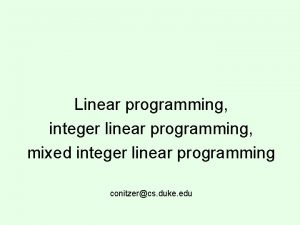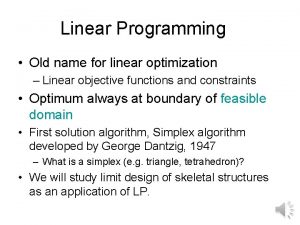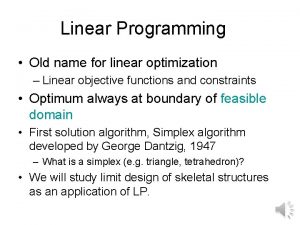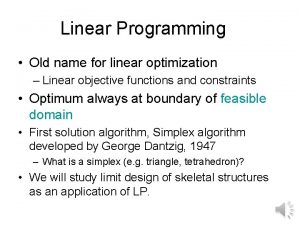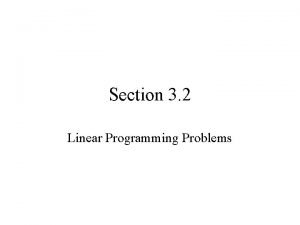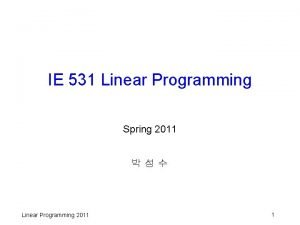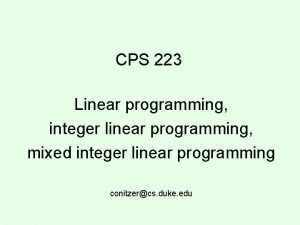Linear Goal Programming 1 What is Goal Programming

















- Slides: 17

Linear Goal Programming 1

What is Goal Programming? • Single objective in formulating LPs so far – – • Several simultaneous objectives in practice – – • Max profit Min cost Max profit Increase reliability Improve employee morale Improve company’s image Goal programming: a way of solving multi-objective problems 2

Categorization of Goal Programming • Nonpreemptive goal programming – Goals with roughly same importance – Assign weights to goals – Construct a single objective function to minimize the weighted sum of deviations from goals • Preemptive goal programming – Hierarchy of priority levels for goals • 1 st priority is to satisfy goal 1 • 2 nd priority is to satisfy goal 2, etc. – Solve sequentially 3

Three Possible Types of Goals • A lower, one-sided goal – a 1 x 1 + a 2 x 2 + … + an xn ≥ b – example: profit exceeds some threshold • An upper, one-sided goal – a 1 x 1 + a 2 x 2 + … + an xn ≤ b – example: cost less than some value • A two-sided goal – a 1 x 1 + a 2 x 2 + … + an xn = b – example: production equal to forecasted demand 4

Dewright Company Example – Nonpreemptive Goal Programming • The Dewright Company is considering three new products to replace current models that are being discontinued, so their OR department has been assigned the task of determining which mix of these products should be produced. Management wants primary consideration given to three factors: long-run profit, stability in the workforce, and the level of capital investment that would be required now for new equipment. In particular, management has established the goals of (1) achieving a long-run profit of at least $125 million from these products, (2) maintaining the current employment level of 4000 employees, and (3) holding the capital investment to less than $55 million. However, management realizes that it probably will not be possible to attain all these goals simultaneously, so it has discussed priorities with the OR department. This discussion has led to setting penalty weights of 5 for missing the profit goal (per $1 million under), 2 for going over the employment goal (per 100 employees), 4 for going under this same goal, and 3 for exceeding the capital investment goal (per $1 million over). Each new product’s contribution to profit, employment level, and capital investment level is proportional to the rate of production. These contributions per unit rate of production are shown in the following table, along with the goals and penalty weights. 5

Dewright Company Example (Cont’d) Unit Contribution Product Factor 1 2 3 Goal (Units) Penalty Weight Long-run profit 12 9 15 ≥ 125 (millions of dollars) 5 Employment level 5 3 4 = 40 (hundreds of employees) 2(+), 4(-) Capital investment 5 7 8 ≤ 55 (millions of dollars) 3 6

Dewright Company Example (Cont’d) • Decision variables x 1: production rate of product 1 x 2: production rate of product 2 x 3: production rate of product 3 • Three goals Profit goal: 12 x 1 + 9 x 2 + 15 x 3 ≥ 125 (lower one-sided goal) Employment goal: 5 x 1 + 3 x 2 + 4 x 3 = 40 (two-sided goal) Investment goal: 5 x 1 + 7 x 2 + 8 x 3 ≤ 55 (upper one-sided goal) • Objective function: Min Z = 5(12 x 1 + 9 x 2 + 15 x 3 – 125)+ 2(5 x 1 + 3 x 2 + 4 x 3 – 40)+ + 4(5 x 1 + 3 x 2 + 4 x 3 – 40)+ 3(5 x 1 + 7 x 2 + 8 x 3 – 55)+ where x if x ≥ 0 + x = x- = 0 if x < 0 0 if x > 0 - x = |x| if x ≤ 0 7

Dewright Company Example (Cont’d) • To put into a proper LP form Let and y 1 = 12 x 1 + 9 x 2 + 15 x 3 – 125 y 2 = 5 x 1 + 3 x 2 + 4 x 3 – 40 y 3 = 5 x 1 + 7 x 2 + 8 x 3 – 55 y 1 = y 1+ - y 1 - and y 1+ ≥ 0, y 1 - ≥ 0 y 2 = y 2+ - y 2 - and y 2+ ≥ 0, y 2 - ≥ 0 y 3 = y 3+ - y 3 - and y 3+ ≥ 0, y 3 - ≥ 0 8

Dewright Company Example (Cont’d) • Final LP for nonpreemptive goal programming: Min Z = 5 y 1 - + 2 y 2+ + 4 y 2 - + 3 y 3+ subject to 12 x 1 + 9 x 2 + 15 x 3 – (y 1+ - y 1 - ) = 125 5 x 1 + 3 x 2 + 4 x 3 – (y 2+ - y 2 - ) = 40 5 x 1 + 7 x 2 + 8 x 3 – (y 3+ - y 3 - ) = 55 xi, yi+, yi- ≥ 0 i=1, 2, 3 add any other functional constraints too 9

Dewright Company Example (Cont’d) • Optimal solution: x 1 = 25/3 x 2 = 0 x 3 = 5/3 y 1+ = y 1 - = 0 → y 1 = 0 → 1 st goal is satisfied y 2+ = 25/3, y 2 - = 0 → y 2 = 25/3 → 2 nd goal exceeds employment level by 25/3 hundred employees y 3+ = y 3 - = 0 → y 3 = 0 → 3 rd goal is satisfied 10

Modified Dewright Company Example Preemptive Goal Programming Priority Level Factor Goal Penalty Weight 1 st Priority Employment level ≤ 40 2 M Capital investment ≤ 55 3 M Long-run profit ≥ 125 5 Employment level ≥ 40 4 2 nd Priority 11

Modified Dewright Company Example Preemptive Goal Programming (Cont’d) • 1 st LP: Min Z = 2 M y 2+ + 3 M y 3+ subject to 5 x 1 + 3 x 2 + 4 x 3 – (y 2+ - y 2 - ) = 40 5 x 1 + 7 x 2 + 8 x 3 – (y 3+ - y 3 - ) = 55 xi ≥ 0 i=1, 2, 3, yi+, yi- ≥ 0 i=2, 3 There are multiple optimal solutions with y 2+ = 0 and y 3+ = 0. To get 2 nd LP, drop y 2+, y 3+ forcing those goals to remain satisfied, also add 2 nd priority constraints 12

Modified Dewright Company Example Preemptive Goal Programming (Cont’d) • 2 nd LP: Min Z = 5 y 1 - + 4 y 2 subject to 12 x 1 + 9 x 2 + 15 x 3 – (y 1+ - y 1 - ) = 125 5 x 1 + 3 x 2 + 4 x 3 + y 2= 40 5 x 1 + 7 x 2 + 8 x 3 + y 3 - = 55 xi ≥ 0 i=1, 2, 3, y 1+, y 1 -, y 2 -, y 3 - ≥ 0 There is a unique solution: x 1 = 5, x 2 = 0, x 3 = 15/4, y 1+ = 0, y 1 - = 35/4, y 2 - = 0 and y 3 - = 0. 13

Dewright Company Example: Compare the two solutions • Solution by nonpreemptive goal programming: (x 1, x 2, x 3 ) = (25/3, 0, 5/3) 12 x 1 + 9 x 2 + 15 x 3 = 125 5 x 1 + 3 x 2 + 4 x 3 = 48. 33 5 x 1 + 7 x 2 + 8 x 3 = 55 profit employment capital investment • Solution by preemptive goal programming: (x 1, x 2, x 3 ) = (5, 0, 15/4) 12 x 1 + 9 x 2 + 15 x 3 = 116. 25 5 x 1 + 3 x 2 + 4 x 3 = 40 5 x 1 + 7 x 2 + 8 x 3 = 55 profit employment capital investment 14

Camyo Manufacturing Example • Camyo Manufacturing produces four parts that require the use of a lathe and a drill press. The two machines operate 10 hours a day. The following table provides the time in minutes required by each part: Part Lathe Drill Press 1 5 3 2 6 2 3 4 6 4 7 4 It is desired to balance the use of the two machines by requiring the difference between their total operation times not to exceed 30 minutes. The market demand limits the number of units produced of each part to at least 10 units. Additionally, the number of units of part 1 may not exceed that of part 2. 15

Camyo Manufacturing Example (Cont’d) • Decision variables xi = number of parts produced per day of type i, i=1, 2, 3, 4 • Operation time goal: – Difference between the time on machine 1 (lathe) and time on machine 2 (drill press) is not to exceed 30 minutes: |time 1 – time 2| ≤ 30 -30 ≤ time 1 – time 2 ≤ 30 time 1 = 5 x 1 + 6 x 2 + 4 x 3 + 7 x 4 lathe time 2 = 3 x 1 + 2 x 2 + 6 x 3 + 4 x 4 drill press -30 ≤ (5 x 1 + 6 x 2 + 4 x 3 + 7 x 4) – (3 x 1 + 2 x 2 + 6 x 3 + 4 x 4) ≤ 30 -30 ≤ 2 x 1 + 4 x 2 - 2 x 3 + 3 x 4 ≤ 30 16

Camyo Manufacturing Example (Cont’d) • Final LP for nonpreemptive goal programming: Min Z = y 1+ + y 2 subject to 5 x 1 + 6 x 2 + 4 x 3 + 7 x 4 ≤ 600 3 x 1 + 2 x 2 + 6 x 3 + 4 x 4 ≤ 600 x 1 ≥ 10 x 2 ≥ 10 x 3 ≥ 10 x 4 ≥ 10 x 1 - x 2 ≤ 0 2 x 1 + 4 x 2 - 2 x 3 + 3 x 4 – (y 1+ - y 1 -) = 30 2 x 1 + 4 x 2 - 2 x 3 + 3 x 4 – (y 2+ - y 2 -) = -30 xi ≥ 0, i=1, 2, 3, 4 yi+ ≥ 0, yi- ≥ 0, i=1, 2 lathe, 600 min in a day drill press, 600 min a day demand must exceed 10 units time 1 - time 2 ≤ 30 time 1 - time 2 ≥ -30 17
 Goal programming example
Goal programming example Perbedaan linear programming dan integer programming
Perbedaan linear programming dan integer programming Linear vs integer programming
Linear vs integer programming Programing adalah
Programing adalah Preemptive goal programming
Preemptive goal programming Goal programming
Goal programming Solving goal programming problems using simplex method
Solving goal programming problems using simplex method Goal programming excel solver
Goal programming excel solver Goal programming
Goal programming Simple linear regression and multiple linear regression
Simple linear regression and multiple linear regression Contoh soal persamaan linear dan non linear
Contoh soal persamaan linear dan non linear Types of non linear text
Types of non linear text Non linear plot example
Non linear plot example Persamaan non linier simultan
Persamaan non linier simultan Linear pipeline
Linear pipeline Examples of linear multimedia
Examples of linear multimedia A left linear grammar is always
A left linear grammar is always Fungsi linear fungsi kuadrat dan fungsi rasional
Fungsi linear fungsi kuadrat dan fungsi rasional
